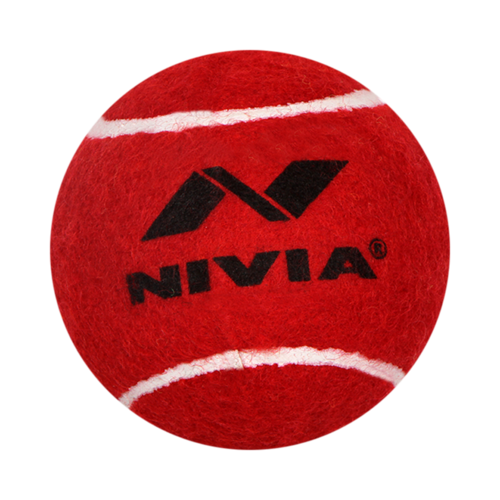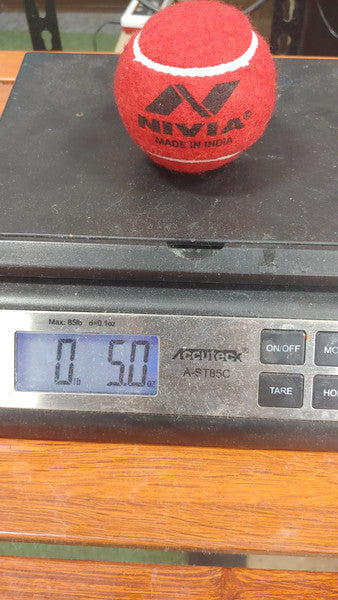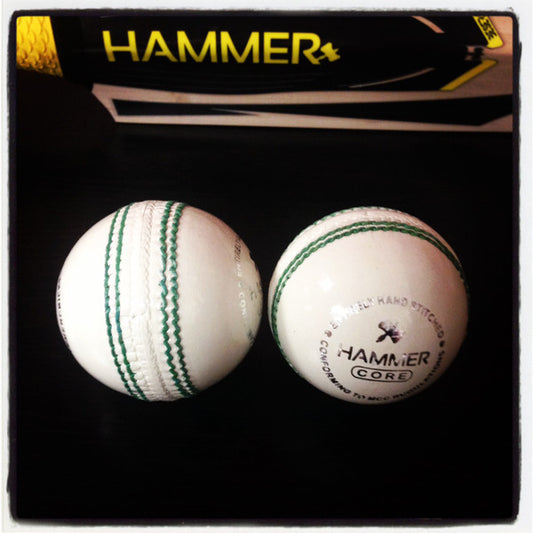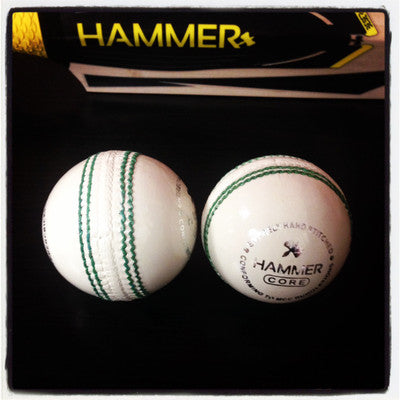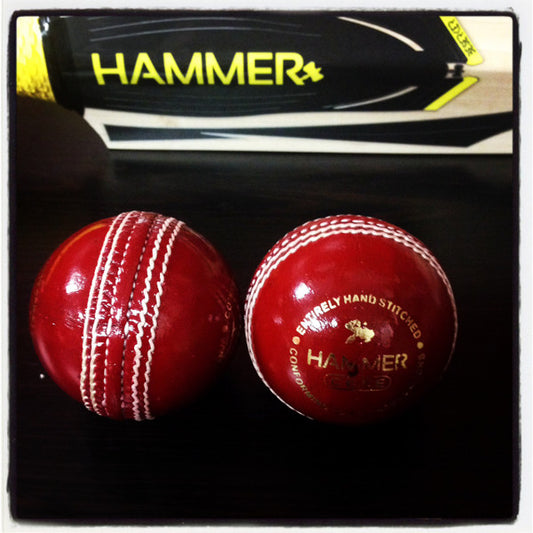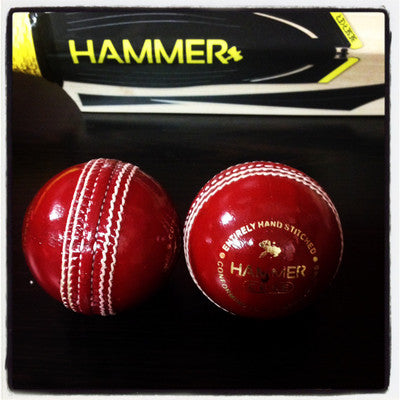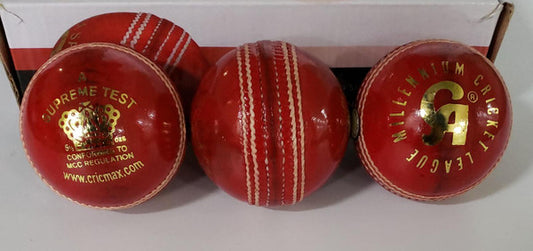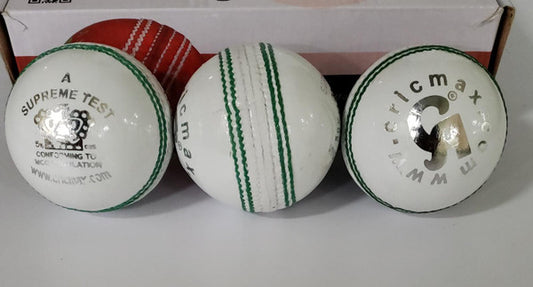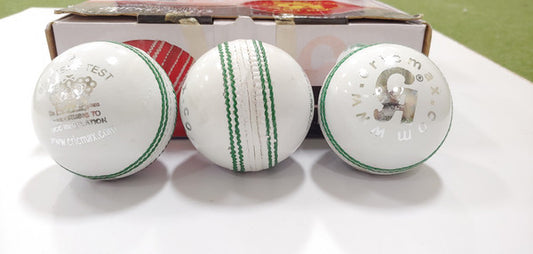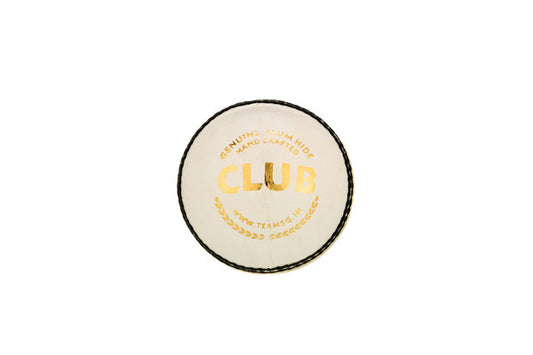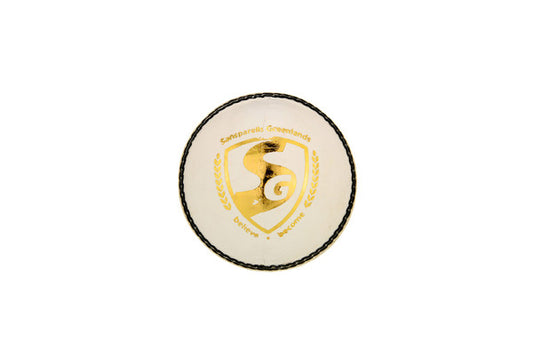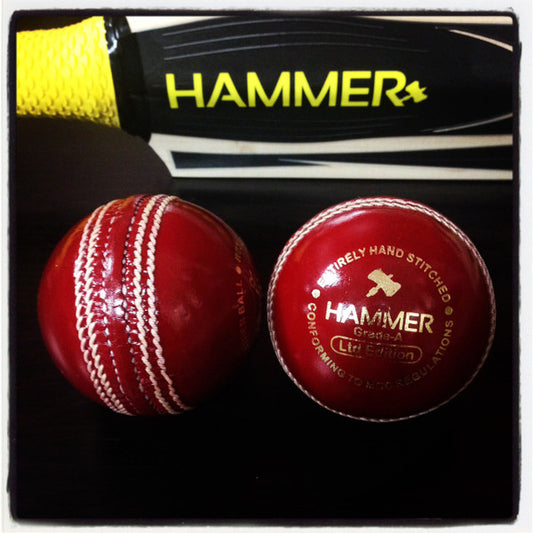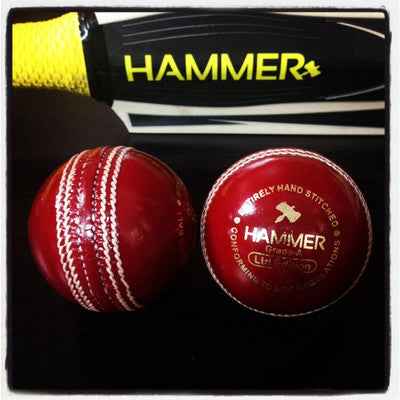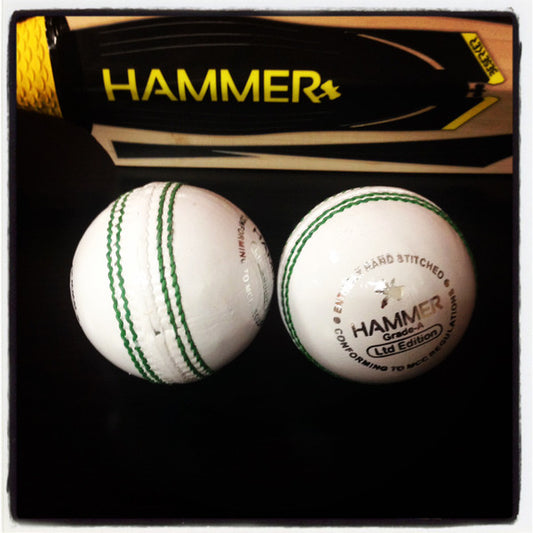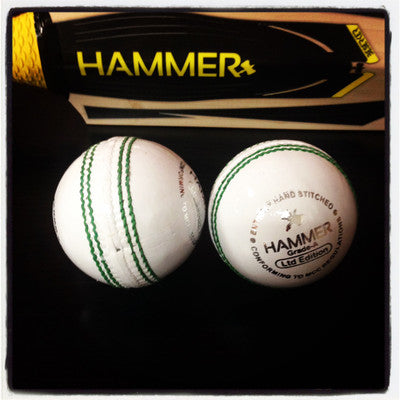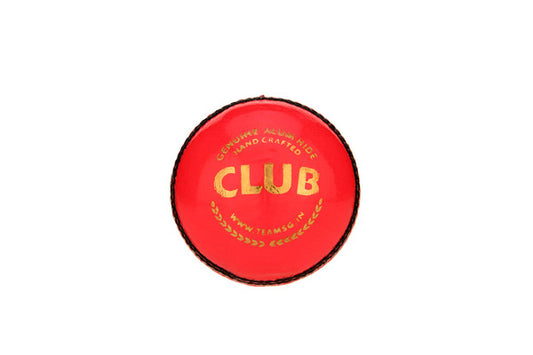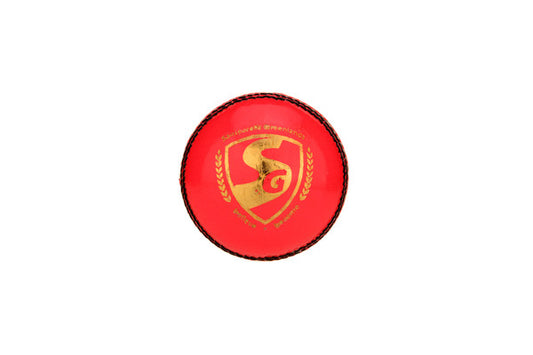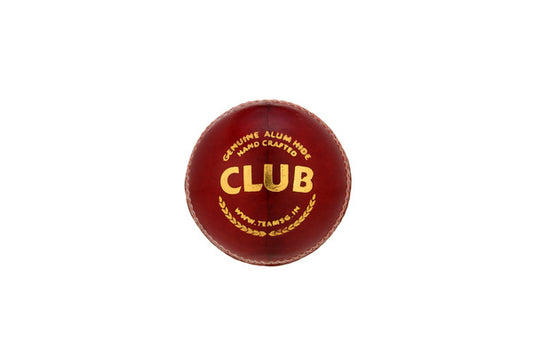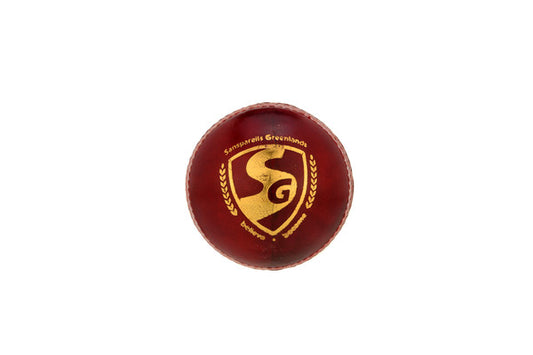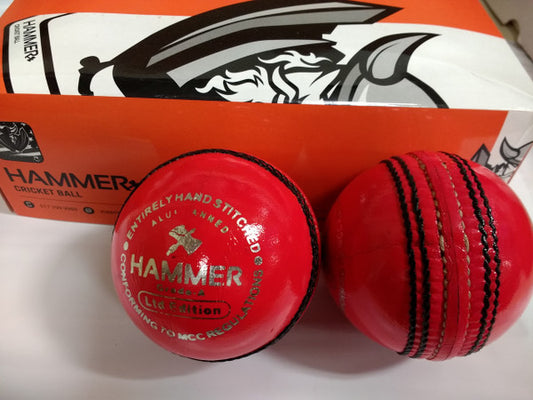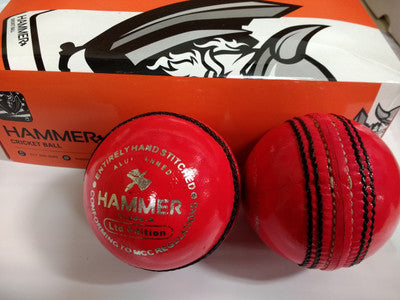Cricket Balls
Cricket balls are one of the defining factors in every match. The quality, condition, and type of ball used can impact swing, bounce, and overall gameplay. But with so many options available, how do you know which one is right for your game?
-
Nivia Heavy Tennis Balls (Red) - Senior Size (Pack of 1)
Save 0%Regular price $2.49Regular priceUnit price / per$2.49Sale price $2.49 -
Hammer Core White Cricket Ball - Senior Size (Pack of 1)
Save 10%Regular price $8.99Regular priceUnit price / per$9.99Sale price $8.99Sale -
Hammer Pro White Cricket Ball - Senior Size (Pack of 1)
Save 7%Regular price $12.99Regular priceUnit price / per$13.99Sale price $12.99Sold out -
Hammer Core Red Cricket Ball - Senior Size (Pack of 1)
Save 10%Regular price $8.99Regular priceUnit price / per$9.99Sale price $8.99Sale -
SG iBall / Hanging Ball (ball with cord)
Save 13%Regular price $12.99Regular priceUnit price / per$14.99Sale price $12.99Sale -
Hammer Pro Red Cricket Ball - Senior Size (Pack of 1)
Save 0%Regular price $12.49Regular priceUnit price / per$12.49Sale price $12.49 -
CA Supreme Test Cricket Ball Red - Senior Size (Pack of 1)
Save 0%Regular price $17.99Regular priceUnit price / per$17.99Sale price $17.99 -
CA Supreme Test Cricket Ball - White - Senior Size (Pack of 1)
Save 0%Regular price $17.99Regular priceUnit price / per$17.99Sale price $17.99 -
Hammer Pro Pink Cricket Ball - Senior Size (Pack of 1)
Save 0%Regular price $12.49Regular priceUnit price / per$12.49Sale price $12.49 -
SG Club Cricket Ball - WHITE - Senior Size (Pack of 1)
Save 15%Regular price $16.99Regular priceUnit price / per$19.99Sale price $16.99Sale -
Hammer LE Red Cricket Ball - Senior Size (Pack of 1)
Save 0%Regular price $14.99Regular priceUnit price / per$14.99Sale price $14.99 -
Hammer LE White Cricket Ball - Senior Size (Pack of 1)
Save 0%Regular price $14.99Regular priceUnit price / per$14.99Sale price $14.99 -
CA Supreme Test Cricket Ball - Pink - Senior Size (Pack of 1)
Save 8%Regular price $16.49Regular priceUnit price / per$17.99Sale price $16.49Sale -
SG Club Cricket Ball - PINK - Senior Size (Pack of 1)
Save 15%Regular price $16.99Regular priceUnit price / per$19.99Sale price $16.99Sale -
SG Club Cricket Ball - RED - Senior Size (Pack of 1)
Save 20%Regular price $15.99Regular priceUnit price / per$19.99Sale price $15.99Sale -
Hammer LE Pink Cricket Ball - Senior Size (Pack of 1)
Save 0%Regular price $14.99Regular priceUnit price / per$14.99Sale price $14.99
Understanding Cricket Balls
Cricket balls are built for performance. They are designed to endure long matches while maintaining their shape and characteristics. Each ball consists of a cork core wrapped in tightly wound string and covered with high-quality leather. The leather is stitched together with a prominent seam, which plays a crucial role in swing, spin, and grip. While all cricket balls share these fundamental elements, differences in materials and craftsmanship set them apart.
The stitching and lacquer finish determine how a ball behaves in different conditions. A well-stitched seam helps bowlers generate movement in the air and off the pitch, while a durable lacquer protects the ball’s surface for extended use.
Types Of Cricket Balls
Cricket balls come in different types, each designed for specific formats, conditions, and levels of play. Choosing the right one depends on the game being played, the playing surface, and the desired durability. Here are the main types:
Red Cricket Balls
Red balls are the traditional choice for Test matches and first-class cricket. Made with high-quality leather, these balls are known for their durability and pronounced seam. They require regular maintenance, as players often shine one side to maintain the ball’s aerodynamics.
White Cricket Balls
White balls are used in One-Day Internationals (ODIs), T20 matches, and other limited-overs formats. They are designed for visibility under floodlights and have a slightly different coating compared to red balls, making them easier to spot. However, they tend to wear out faster and lose their shine more quickly.
Pink Cricket Balls
Pink balls were introduced for day-night Test matches to improve visibility under artificial lights. They are manufactured with a special dye and coating to help them retain color longer than white balls while behaving similarly to red balls in terms of movement and bounce.
Training And Practice Balls
For practice sessions, players often use specially designed training balls. These include:
- Swing Balls: These balls are designed to exaggerate swing in the air, allowing bowlers to refine their control and seam positioning while helping batters practice their shot adjustments against moving deliveries.
- Soft Training Balls: These balls are lighter and softer than standard cricket balls, making them ideal for beginners, coaching drills, and fielding practice without the risk of injury.
- Weighted Balls: Slightly heavier than regulation cricket balls, weighted balls help players build strength in their arms and wrists.
Tennis And Rubber Cricket Balls
Casual and street cricket often involve tennis balls or rubber cricket balls. These are softer, lighter, and safer for informal games while still allowing players to develop basic skills. Some are even designed with a seam to mimic real cricket ball movement.
Factors To Consider When Choosing A Cricket Ball
Selecting the right cricket ball isn’t just about picking any option off the shelf. Several key factors affect performance, durability, and overall experience. Here’s what you should consider before making a purchase:
Leather Quality
The quality of a cricket ball's leather affects its shape and durability. Premium-grade leather is used for professional and high-level matches, while lower-grade leather or synthetic alternatives are more common in practice and casual play.
Stitching And Seam
A cricket ball’s seam is crucial for swing and seam movement. Hand-stitched seams provide better grip and durability compared to machine-stitched seams, which are often found on lower-quality balls. A pronounced seam benefits bowlers, while a flatter seam is more batter-friendly.
Weight And Size
The standard weight for men’s cricket balls is 155.9g to 163g. On the other hand, women’s balls range from 140g to 151g. Junior cricketers use slightly smaller and lighter balls, ensuring they can handle them comfortably while developing their technique.
Durability
Durability depends on the quality of the leather, the core materials, and how well the ball is maintained. High-quality balls last longer and provide consistent performance during a match. In contrast, lower-quality balls may quickly lose their shape, shine, or seam integrity.
Price And Purpose
Cricket balls range from budget-friendly options for casual play to premium, professionally crafted balls used in high-level matches. Investing in a high-quality ball ensures better durability, consistent bounce, and superior seam movement, making it a smart choice for serious players. On the other hand, training balls or lower-cost alternatives can be useful for practice sessions where longevity and performance under match conditions are less critical.

Why High-Quality Cricket Balls Matter
A cricket ball directly affects how a match unfolds. Investing in high-quality cricket balls benefits both players and the game in several ways:
Consistent Performance
A well-made ball maintains its shape, seam, and bounce throughout an innings. Cheap or poorly manufactured balls tend to lose their hardness quickly, resulting in inconsistent bounce and reduced movement for bowlers. When a ball deteriorates too soon, it affects both batters and bowlers, making the game unpredictable and frustrating.
Better Swing And Spin
High-quality cricket balls have a pronounced, well-stitched seam, which is essential for bowlers looking to generate movement through the air or off the pitch. A strong seam allows fast bowlers to achieve controlled swing, while spinners can get a better grip to impart sharp turn. If the seam wears down too soon, bowlers lose their ability to influence the game.
Durability And Longevity
Cheap balls often lose their shine, go soft, or lose shape after just a few overs. In contrast, premium cricket balls are made with genuine leather, multiple layers of tightly wound string, and a durable cork core. They can last an entire match or longer, making them a must-have for competitive matches and serious training sessions.
Improved Safety
A well-constructed cricket ball provides the right balance of hardness and resilience, reducing unpredictable behavior that could lead to injuries. Low-quality balls may crack, become too soft, or behave unpredictably, increasing the risk for both batters and fielders.
Fair Competition
A high-quality ball ensures a fair contest between bat and ball. It retains its characteristics longer, giving bowlers a chance to use seam and swing, while batters can trust its bounce and pace. In contrast, a subpar ball can skew the game by becoming lifeless too quickly.
Cost-Effectiveness In The Long Run
While premium cricket balls may have a higher upfront cost, their durability makes them a more economical choice over time. A cheap ball that wears out quickly needs to be replaced frequently, leading to higher overall costs for teams, clubs, and individual players. Investing in a high-quality ball ensures longer-lasting play and fewer disruptions due to ball replacements.
How Cricket Store Online Meets All Cricket Ball Needs
As cricketers ourselves, we understand the frustration of playing with subpar equipment. That’s why we source our cricket balls from the most trusted global brands, ensuring that each ball meets the highest standards—whether it’s for competitive matches, training, or casual play.
A Wide Range Of Cricket Balls For Every Need
At Cricket Store Online, we offer a carefully curated selection of cricket balls designed for different formats and levels of play. Whether you need a red ball for long-format matches, a white ball for limited-overs cricket, or a pink ball for day-night games, we have high-quality options from the most reputable brands.
Unmatched Quality And Expert Recommendations
Our expert team, backed by 20+ years of experience, provides personalized recommendations based on your level, playing conditions, and personal preferences. Unlike many retailers that stock mass-produced, low-quality options, we work directly with top brands to ensure every ball meets professional-grade standards.
Competitive Prices And Hassle-Free Shopping
Buying high-quality cricket balls shouldn’t be a struggle. We’ve built Cricket Store Online to be the ultimate destination for cricketers, combining top-quality products with competitive pricing and an easy shopping experience.
Best-Selling Cricket Balls At Cricket Store Online
Nivia Heavy Tennis Balls (Red)
Purpose: Training & Recreational Cricket
This ball is specifically designed for cricket training and recreational matches. Its soft finish and high-quality materials make it ideal for beginners transitioning from tennis ball cricket to hard-ball formats. The extra weight provides a more realistic feel while still being easy on the hands, making it a great choice for practice drills, casual backyard cricket, or youth training sessions.
Hammer Core White Cricket Ball
Purpose: Training & Club-Level Matches
The Hammer Core White Cricket Ball is a superb practice ball that closely mimics the feel of a match ball. Made with Grade 4 cowhide leather, it features a pronounced seam with 60-65 stitches. Inside, a solid cork core ensures shape retention and bounce consistency over time. Weighing 156g (5.5 oz), this senior-sized ball is perfect for club cricketers, net sessions, and those looking for a cost-effective training ball that doesn’t compromise on quality.
Hammer Core Red Cricket Ball
Purpose: Training & Entry-Level Matches
Built for beginners and club-level players, the Hammer Core Red Cricket Ball features a full cork center and a moderate stitch count of 60-65. Weighing 156g (5.5 oz) and manufactured in Pakistan, this ball is great for players transitioning to hard-ball cricket, net practice, and coaching drills. It offers an affordable option for training sessions while still providing a real match-like experience.
CA Supreme Test Cricket Ball (White)
Purpose: Professional & League Matches
The CA Supreme Test White Cricket Ball is made from premium chrome leather, ensuring durability across extended matches. The hand-stitched seam (80+ stitches) provides superior grip and movement, while its five-layer Portuguese and New Zealand cork core, bound with wool, allows the ball to retain shape and bounce even after long spells of play. With its 4-piece construction, this ball delivers excellent seam retention and swing capabilities. It is custom-made for USA weather conditions and can last up to 80 overs, making it an excellent choice for league cricketers, professional matches, and extended play.
SG Super Club Cricket Ball (Pink)
Purpose: Club & League Matches
The SG Super Club Pink Cricket Ball is designed for night matches and club-level games, offering excellent visibility under artificial lighting. Made from high-quality alum-tanned leather, this ball is waterproofed for resilience in varying weather conditions. Its solid one-piece grade 2 core ensures durability, while the 4-piece construction helps maintain a consistent shape and bounce. This ball is a great choice for club cricketers and leagues looking for a high-quality pink ball alternative for competitive play.
Choosing The Right Cricket Ball For Your Game
With so many cricket ball options available, selecting the right one depends on various factors, including match format, level of play, and training needs. Here’s a breakdown to help you make the best choice:
Match Or Training
Competitive matches require high-quality leather balls with solid cork cores for durability and consistent performance. These balls are designed to maintain their seam, bounce, and hardness over extended play. For training, practice balls with moderate stitch counts, synthetic materials, or slightly softer constructions can provide a cost-effective alternative.
Format
Red balls are the standard choice for longer formats like Test cricket, first-class matches, and traditional league games. White balls are preferred for ODIs and T20 matches due to their high visibility. Pink balls are ideal for day-night cricket, as they maintain visibility under floodlights and feature a special dye and coating to preserve shine longer.
Level Of Play
Beginners and junior players benefit from softer, more affordable cricket balls that allow them to develop confidence and technique without the risk of injury. Intermediate and club-level players should opt for hand-stitched leather balls with a pronounced seam and solid cork core for durability and skill improvement. Professionals and serious competitors need premium-grade, match-quality cricket balls that retain their structure, maintain consistent swing, and deliver top-level performance in demanding conditions.
Read also:
Frequently Asked Questions
What are 6 balls in cricket called?
In cricket, a set of six legal deliveries bowled by a bowler is called an over. Once an over is completed, another bowler takes over from the opposite end. The number of overs in a match depends on the format, such as 20 overs in T20, 50 overs in ODIs, and unlimited overs in Test matches.
Are cricket balls harder than baseballs?
Yes, cricket balls are harder than baseballs because they have a solid cork core and a tightly wound leather exterior. Baseballs have a softer core made of cork and rubber, making them slightly less dense. The hardness of a cricket ball allows for more pronounced seam movement and swing in the air.
Which ball is called a yorker?
A yorker is a delivery that lands near the batter’s feet, close to the popping crease, making it difficult to play. It is commonly used by fast bowlers, especially in death overs of limited-overs cricket, to prevent big shots. A well-executed yorker is one of the most effective deliveries in cricket.
How many balls are in 10 overs?
Each over consists of six legal deliveries, so in 10 overs, there are 60 balls (excluding wides and no-balls). In shorter formats like T20, these 60 balls are crucial in determining the game’s flow. A bowler can bowl a maximum of four overs in T20s and ten in ODIs.
Who hits the ball in cricket?
The batter (or batsman) is responsible for hitting the ball bowled by the bowler. Batters aim to score runs while defending their stumps from being hit. A successful batter must judge pace, spin, and movement to play effective shots.
Why is the pink ball used in day-night Test matches?
The pink ball is used in day-night Test cricket because it offers better visibility under artificial lights. Red balls become hard to see under floodlights, while white balls are not suitable for Test matches due to excessive wear. The pink ball retains its visibility longer while maintaining characteristics similar to a red ball.

